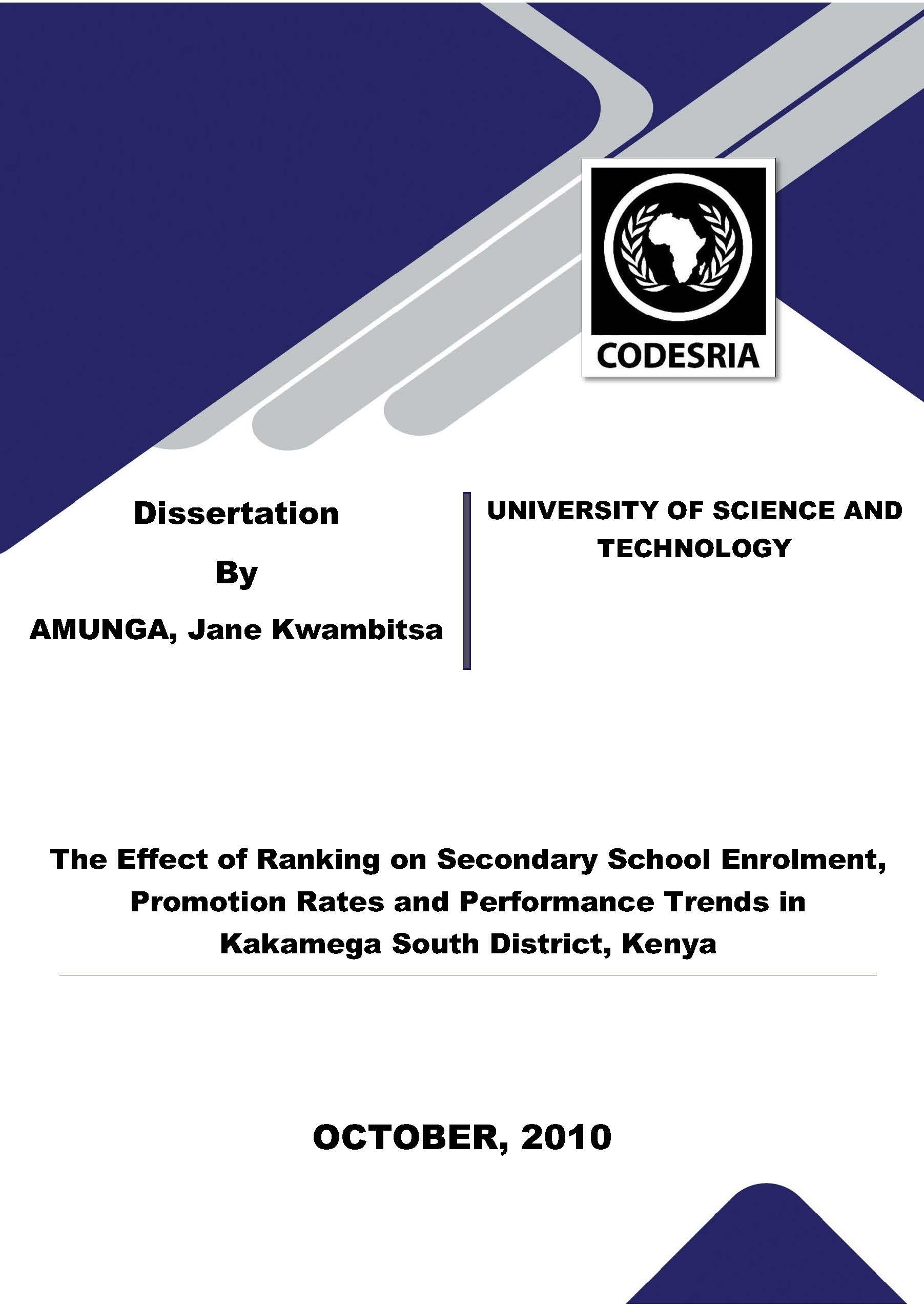The Effect of Ranking on Secondary School Enrolment, Promotion Rates and Performance Trends in Kakamega South District, Kenya
Mots-clés :
Effect, Ranking, secondary school, Enrolement, promotion, Rates and performanceSynopsis
The objectives of this study were to establish the effect of ranking schools and students in national examinations on enrolment, promotion rates and performance trends. It was also meant to investigate the teachers' and students' perception of ranking. lt was guided by the null hypotheses that there is no significant relationship between the school performance index and enrolment, promotion rates and performance trends. Ranking schools and students in National Examinations creates the impression that there are good and bad schools in Kenya. The top performing schools are regarded as effective schools while low performing are regarded as ineffective schools. This belief influenced enrolment, promotion rates and performance trends in different schools. It also affected perception of teachers' and students. It is expected that the study will assist the Ministry of Education consider other factors that should be used in ranking schools and students, particularly those suggested by teachers and students like use of CATs and Value Added. It will also help policy makers in addressing under-enrolment or over-enrolment problems caused by ranking. Schreen's conceptual framework on School Effectiveness was adapted to suit the study. The key
variables that were studied are enrolment, promotion rates, achievement measured by the performance index (mean score) upon which ranking is based and perceptions. The study covered Kakamega South District. A descriptive survey research design was used and head teachers, teachers and students from secondary schools in Kakamega South District formed the study population. The sample frame consisted of 75 secondary schools stratified according to performance into low ranked schools,
average ranked schools and top ranked ranked categories. The sample size consisted of 36 schools (12 from each performance category) selected by random sampling and 252 respondents selected purposively from the 36 schools. Data·collection instruments_ were the questionnaire and document analysis guide. Reliability of the instrument was established by use of test retest technique while validity was established by assessing the items on the instrument and ensuring that they appeared
relevant, meaningful and appropriate to the respondents. The data collected were analysed
Téléchargements
Références
ADEA (2002). Reaching Out, Reaching Ali, Sustaining Effective Policy for Education in Africa
Fighting HIVIAIDS. Proceedings of ADEA Benial Meeting7-l l. Paris: Association for Development of
Education in Africa.
Adnett, N. & Davies, P. (2003). Schooling Reforms in England: From Quasi Markets to Competition?
Journal of Education Policy 18 (4) 8-1O.
Adnett, N. & Davies, P. (2000). Competition and Curriculum Diversity in Local Schooling Markets:
Theory and Evidence. Journal of Education Policy 15(2) 157- 167.
Aduda, D. (2007, December 22). Western Schools make a Comeback in Exam Results.
Daily Nation, p2
Akers, J., Migoli, J. & Nzomo, J. (2001). Identifying and Addressing the causes ofDeclining
Participation Rates in Kenyan Primary Schools. International Journal of Educational Development 21,
-374.
Behrman, J.R. (1996). Measuring the Effectiveness of School Policies in Developing Countries:
Revisiting Issues ofMethodology. Economies of Education Review 15 (4), 345-364.
Board ofStudies; NSW (2008). Studyingfor New South Wales Higher School Certificate: An Information
Booldetfor Year JO students. Sydney: Board of Studies; NSW.
Bogonko, S.N. (1992). A History of Modern Education in Kenya (1895-1991). 49-136.
Nairobi: Evans Brothers.
Bradley, S., Crouchley, R., Millington, J. & Taylor, J. (2000). Testing for Quasi Market Forces in
Secondary School Education. Oxford Bulletin of Economies and Statistics, 16(3) 357-390.
Bradley, S. & Taylor, J. (2000). The effect of the Quasi Market on the Efficiency Equity trade-off
in the secondary school sector; Lancaster University School. Discussion Paper Ec9/00
Bray, M. (2003). Adverse effects of private supplementary tutoring: Dimensions, Implications an
Government Responses. Paris: UNESCO.
Bregman, J. & Stallmerster, S. (2002). Secondary Education in A.frica: Strategiesfor Renewal.
Washington D.C: African Region Human Development.
Briseid, O.& Caillods, F. (2004). Trends in secondary education in industrialized countries: Are
they relevant for African countries? UNESCO: International Institute for Educational
Planning
Burgess, S., Propper, C. & Wilson D. (2002). Will more choice improve outcomes in education
and Health care? Evidencefrom Economie Research.
Bristol. httpl/www.bris.ac.uk/Depts/CMPO/Choice.pdf Retrieved 15 July,2007.
Republic of Kenya (2002). Kenya 1999 Population and Housing Census: Analytical Report on Population
Projections Vol VII. Nairobi: Central Bureau of Statistics.
Chapman, D. W. & Synder, C.W. (2000). Can High Stakes National Testing Improve Instruction?
Re-examining Conventional Wisdom. International Journal of Educational Development 20,
-474.
Christopher J. (2002). Effects of Private School Competition on Student Achievement. Journal of
Urban Economies.
Cohen,L., Manion,L., & Morrison, K (2000). Research Methods in Education. London:
Routledge.
Eshiwani, G. (1993). Education in Kenya since Independence 35-189. Nairobi: East African
Publishers.
Evers, W. &Walberg, H. (2003). School Accountability, An Assessment ofby Kovet Task Force
on K-12 Education. Stanford, C. A: Hoover Institution Press.
Figlio, D. N. & Getzler, S. (2002). Accountability, Ability and Disability. Gaming the System?
National Bureau of Economic Research. Working Paper 970, 7.
Figlio, D.& Winicki, J. (2004). Food for thought? The Effects of School Accountability plans on
School Nutrition .Journal of Public Economics.
Fitz-Gibbon, C. T. (1996). Monitoring Education: Indicators, Quality and Effectiveness. London:
Cassel.
Gillborn, D. (1996). Exclusions from school: Viewpoint. London: Institute of Education.
Hanushek, E. & Raymond M. (2002). Sorting out Accountability System. In Williamson, M. &
Walberg, N.(Eds). School Accountability. Stanford: Hoover Institute Press.
Hickman, J., Henrick, C, J. & Smith, J. (2002). The Performance of Performance Standards.
Journal of Human Resources 37(4), 778-881.
Herbert, J. & Hauser, M. (Eds). (1999). High Stakes; Testing/or tracking, Promotion and
Graduation. Washington: National Academy Press.
Institute of Policy Analysis and Research ( IPAR,2004). The sociology of Private Tuition, 10 (7).
James, M. (1998). Using Assessment for School Achievement. Oxford: Heinman.
Kellaghan, T. & Greaney, V. (2001).Using Assessment to Improve the Quality of Education 9-29.
Paris: International Institute for Educational Planning.






